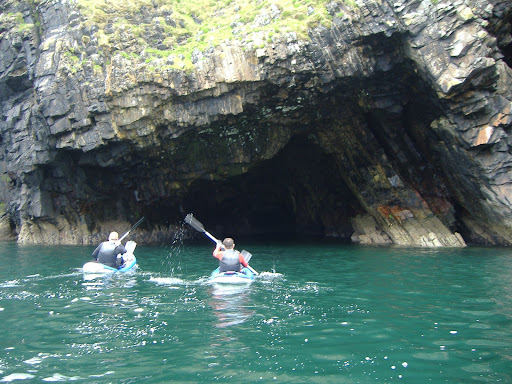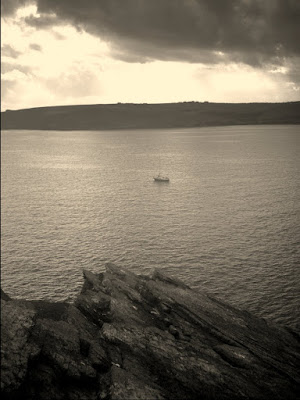We slipped our mooring early on a foggy Saturday, motoring on a sea as slick and smooth as silk. Outside the cove, we steered into blank fog, trusting to
GPS. We were not the first to sea, however - the surface was thick with birds a-fishing, and I glimpsed the fin of a hunting dolphin. A long line of tall masts loomed out of the murk: yachts in a line, racing in slow-motion, inching out to open water in the slackest conceivable wind. By the time we dropped anchor in the great cliff-lined bight of
Holeopen Bay, our inflatable canoes were rigged and ready to launch. Festooned with torches, light-sticks and cameras, we abandoned
Briongloid. Soon, a little flotilla of two canoes and a dinghy paddled off to the foot of the mighty sea-cliffs which define
Holeopen Bay. Beneath the Old Head of Kinsale
Beneath the Old Head of KinsaleUsing an ancient ruined tower on the cliff-tops as a guide, we soon found what we were looking for: the entrance to tunnels which pass clear through the Old Head of Kinsale, running east-west from
Holeopen Bay to Courtmacsherry Bay. The first tunnel was a little narrow, but the second had a large and welcoming entrance. Inside the cave - surprisingly well lit - we soon began to feel the up/down motion of the swell, amplified by the funnel-shape of the entrance. Progress along the narrowing tunnel was good, until the last fifteen or so metres, when Mr T ran the lead canoe hard aground on a barely-submerged boulder. No sooner was the problem announced, when a roar from behind me announced the solution - and a breaking wave lifted me well above Mr T before launching me forward into his back and blasting us both well clear of the obstruction.
A second wave followed the first, and soon we were both capsized, grabbing in the darkness for boats and paddles, and bracing for the next breaker. Turning, I saw Mr. J approaching in Briongloid's dinghy, the tunnel so narrow that he had to paddle with a single oar. I shouted a warning just as he ran aground. Just then, the next breaker reared behind him, before breaking over the dinghy. A good time to send the dinghy back... I waited in the blackness and the crashing of the waves until the dinghy was safely on its way.
 Choosing a tunnel
Choosing a tunnelMy swimming fins being already on my feet, I turned my face to the light, and covered the last few metres into Courtmacsherry Bay as a swimmer, pushing my kayak and paddle before me. The western side of the headland was just as dramatic as I remembered - even taller and steeper cliffs, and a huge sea-stack covered in nesting birds. Big grins from me and Mr. T - a long time since we'ld first attempted the transit, and great to be finally through. We found a second tunnel - much wider - and a little hairy paddling later, were safely back in
Holeopen Bay, and boarding
Briongloid, ready for our lunch.
By now, the sun had burnt the fog from the water and a gentle breeze had got up; we weighed anchor under sail and tacked out around the
Old Head of Kinsale under a perfect summer sky. Angler's boats dotted the water, and helicopters circled the lighthouse on the headland - a really spectacular backdrop. Tacking gently southward with main and genoa, we moved out to sea, hoping for a sighting of a Minke whale, or perhaps a Basking Shark. We spent the rest of the afternoon on a single tack, moving gently on the clear blue water of the open ocean as the coast behind us diminished to a smudge on the horizon. Dinner was served about 19:00, by which point we were about 19km almost due south of Oysterhaven - within a mile or two of the grave of the
Lusitania; time to jibe for home, and work north as the summer sun sank slowly towards the land. Picking up our mooring just after sunset, our distance for the day was 54km aboard
Briongloid under power and sail, and perhaps another 2km in canoes and dinghies.



